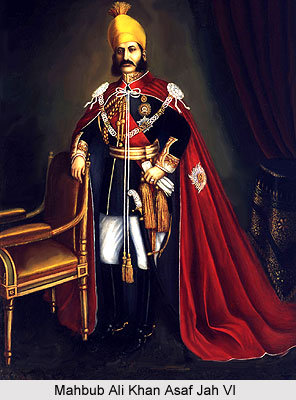 Mahbub Ali Khan Asaf Jah VI, also known as Asaf Jah VI Mir Mahboob Ali Khan Siddiqi was the sixth Nizam of the princely state of Hyderabad, which was the title of the ruler of Hyderabad State in India. He was born 17th August 1866 and reigned over the region from the year 1869 to 1911. His style and official full name was Nawab Bahadur Sirajud Dawlah, Lieutenant General His Highness Rustam-i-Dauran, Arustu-i-Zaman, Wal Mamaluk, Asaf Jah VI, Muzaffar ul-Mamaluk, Nizam ul-Mulk, Nizam ud-Daula, Nawab Mir Sir Mahbub Ali Khan Bahadur, Sipah Salar, Fath Jang, Nizam of Hyderabad, Knight Grand Cross of the Most Honourable Order of the Bath, Knight Grand Commander of the Most Exalted Order of the Star of India, Kaiser-i-Hind, Honourable Lieutenant General in the Army.
Mahbub Ali Khan Asaf Jah VI, also known as Asaf Jah VI Mir Mahboob Ali Khan Siddiqi was the sixth Nizam of the princely state of Hyderabad, which was the title of the ruler of Hyderabad State in India. He was born 17th August 1866 and reigned over the region from the year 1869 to 1911. His style and official full name was Nawab Bahadur Sirajud Dawlah, Lieutenant General His Highness Rustam-i-Dauran, Arustu-i-Zaman, Wal Mamaluk, Asaf Jah VI, Muzaffar ul-Mamaluk, Nizam ul-Mulk, Nizam ud-Daula, Nawab Mir Sir Mahbub Ali Khan Bahadur, Sipah Salar, Fath Jang, Nizam of Hyderabad, Knight Grand Cross of the Most Honourable Order of the Bath, Knight Grand Commander of the Most Exalted Order of the Star of India, Kaiser-i-Hind, Honourable Lieutenant General in the Army.
Early Life of Mahbub Ali Khan Asaf Jah VI
Mahbub Ali Khan Asaf Jah VI was born on August 17th, 1866 to father Afzal ad-Dawlah, Asaf Jah V. After the death of his father, Mahbub Ali succeeded him and became the ninth Nizam of the Asaf Jahi dynasty in the year 1869. Mir Turab Ali Khan, Salar Jung I, Nawab Rasheed-ud-din Khan Shams-ul-Umra III, who functioned as regent, installed him as the Nizam, after he reached the age of majority. Mahbub Ali Khan received education from the British and special focus was given to his studies. Mir Turab Ali Khan, Salar Jung I had a great influence on Asaf Jah VI.
Personal Life of Mahbub Ali Khan Asaf Jah VI
Mahbub Ali Khan Asaf Jah VI was a well known and much revered ruler. He was popularly addressed as Mahbub Ali Pasha. He was also given the title Arastu Yar Jung by the Dr. Abdul Husain, his physician. The Nizam of Hyderabad was famous for copious lifestyle and luxuries and was highly enthusiastic about cars and fascinating clothes. He had the most extensive collection of garments ranging from coats, sherwanis, headgear, shirts, walking sticks, shoes, collars, perfumes etc. He dedicated an entire wing of his palace for the proper maintenance of his wardrobe. The elegant ruler never wore the same outfit twice.
Asaf Jah VI also bought the Jacob Diamond, which is an outstanding specimen amongst the Jewels of The Nizams. It is now under the ownership of the Government of India.
Titles of Mahbub Ali Khan Asaf Jah VI
Mahbub Ali Khan Asaf Jah VI held many titles and styles which are mentioned as follows-
* Sahibzada Mir Mahbub Ali Khan Siddiqi Bahadur (1866- 1869)
* His Highness Rustam-i-Dauran, Arustu-i-Zaman, Wal Mamaluk, Asaf Jah VI, Muzaffar ul-Mamaluk, Nizam ul-Mulk, Nizam ud-Daula, Nawab Mir Mahbub Ali Khan Bahadur, Sipah Salar, Fath Jang, Nizam of Hyderabad (1869- 1877)
* His Highness Rustam-i-Dauran, Arustu-i-Zaman, Wal Mamaluk, Asaf Jah VI, Muzaffar ul-Mamaluk, Nizam ul-Mulk, Nizam ud-Daula, Nawab Mir Mahbub Ali Khan Siddiqi Bahadur, Sipah Salar, Fath Jang, Nizam of Hyderabad, KIH (1877- 1884)
* His Highness Rustam-i-Dauran, Arustu-i-Zaman, Wal Mamaluk, Asaf Jah VI, Muzaffar ul-Mamaluk, Nizam ul-Mulk, Nizam ud-Daula, Nawab Mir Sir Mahbub Ali Khan Bahadur, Sipah Salar, Fath Jang, Nizam of Hyderabad, GCSI, KIH (1884- 1902)
* His Highness Rustam-i-Dauran, Arustu-i-Zaman, Wal Mamaluk, Asaf Jah VI, Muzaffar ul-Mamaluk, Nizam ul-Mulk, Nizam ud-Daula, Nawab Mir Sir Mahbub Ali Khan Bahadur, Sipah Salar, Fath Jang, Nizam of Hyderabad, GCB, GCSI, KIH (1902- 1910)
* Lieutenant-General His Highness Rustam-i-Dauran, Arustu-i-Zaman, Wal Mamaluk, Asaf Jah VI, Muzaffar ul-Mamaluk, Nizam ul-Mulk, Nizam ud-Daula, Nawab Mir Sir Mahbub `Ali Khan Siddiqi Bahadur, Sipah Salar, Fath Jang, Nizam of Hyderabad, GCB, GCSI, KIH (1910- 1911)
Honours of Mahbub Ali Khan Asaf Jah VI
The Nizam of the princely state of Hyderabad received several honours through out his reign. These are listed below-
* Kaiser-i-Hind Gold Medal- KIH (1877)
* Knight Grand Commander of the Order of the Star of India- GCSI (1884)
* Knight Grand Cross of the Order of the Bath- GCB (1902)
* Delhi Durbar Gold Medal (1903)
* Grand Cross of the Order of the Red Eagle of Prussia (1911)



















